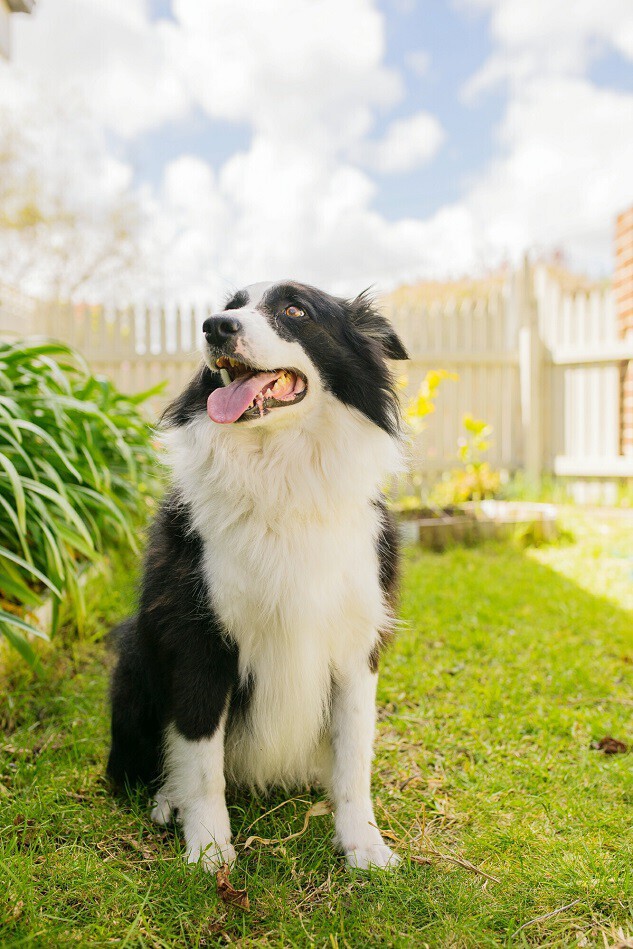It helps to start by knowing which plants are toxic and are not toxic to pets.

Taking a walk with your dog is healthy for both you and your canine friend. But for daily exercise, you don't need to step far beyond your own backyard. "As we approach the warmer months, pet owners may spend more time outside with their pets," says Rachel Maso, CPDT-KA, senior manager for behavior of the adoption center at the ASPCA. "It is a good idea to make sure your pup is comfortable in your yard. Oftentimes, when dogs are left alone in the yard, they can become bored and pick up bad habits such as excessive barking, digging, or plotting an escape from their fenced-in yard."
Landscaping your backyard does more than offer a more attractive view. In fact, you can help stimulate your pet's mind, strengthen the bond with your pet, and work on behavior training. You also don't have to make sweeping changes to turn your backyard into a canine paradise. Small additions to your yard can make a huge difference in improving the experience for your pet. "Giving your dog lots of condoned activities to keep busy in the yard will not only help your pup to build better habits, but will help your dog to enjoy their time outside," Maso says. "No one wants their yard 'going to the dogs' and some simple DIY supplies can save your flowers while allowing you to show your dog a good time." For that, she recommends the following tips.
Provide Water and Shelter
One of the first things that Maso says that pet owners can do to improve their backyards for their pets is to ensure that there is enough water and shade. Access to water is especially important during the warmer months when heat stroke is a higher risk. And it goes without saying that you should avoid leaving your dog unattended for long periods of time. "As a highly social species, they crave time with their people and can develop problem behaviors if left alone for too long," she says.
Install a Fence
Dogs are naturally curious. If they can get out of your yard to investigate the squirrels over in your neighbor's backyard, they will. Dogs may also end up out wandering the neighborhood if a physical barrier, like a fence, is not in place. "Physical fences are encouraged! Especially if you plan to let your pup off leash," Maso explains. "You should use your judgement about what type of fence is safe and appropriate for your dog." The barrier might not keep the most determined dogs within its parameters (which is why you should be keeping a vigilant supervision on your dog), but it does provide clear boundaries for most dogs. You should also take the time to train your dog to know not to leave the yard unless you have given permission.
Provide Places to Dig
Dogs love digging in the dirt, the flower beds, and under the fence. Give them better alternatives. "Try incorporating a soft sand play area for dogs that enjoy digging," Maso says. "This will keep them busy and keep them out of your grass and garden." You can hide toys and treats around the yard for your dog to find, placing them in your approved digging areas to give your dog mental stimulation and exercise. Nothing is more exciting than seeing our canine pals so excited about playing out in the yard.
Offer Ways to Cool Off
In addition to a readily available water bowl, you can also provide other ways to cool off. Maso says that not all dogs enjoy playing in water, but a sprinkler or a small pool that provides some cool relief from the hot sun in the summer is a good idea. You can also add an elevated bed under some shade. "It gives your pup a place to get off warm pavement and will encourage them to relax in the area of your choosing," she says. Whatever you do, it's important to keep your pet cool and comfortable during the hottest days of the year.
Grow Only Non-Toxic Plants in the Garden
Flowers are beautiful and we certainly love gardens, but we also have to be mindful of those plants that are toxic to our animals (or any animals that may visit our yards). The ASPCA provides a list of the plants that are safe for your dog, as well as a list of those that are too dangerous to have in your yard. Azaleas, butterfly irises, and daisies are toxic to dogs and can make them sick, or worse. Instead plant flowers like baby's breath, African daisies, and cornflowers in your garden. Train your dog not to dig in the flowerbeds, but this way you know that your pet is generally safe if she still decides that the flowers are a snack the moment you look away.
Build a Pet Playground
Dog parks have all types of interesting equipment. Why not set up a few in your yard? You can find slides and other playground equipment built just for your dog's entertainment. "For dogs that love to get height, a bench or a child's plastic slide set might be a welcome addition to the yard!" Maso says. From dog agility kits to dog teeter-totters and crawl tunnels, your dog can have an entire playground right in his backyard. An enriched backyard helps your dog to express his natural behaviors, like digging, barking, and running, in a safe and controlled environment, while going a long way toward keeping your backyard from becoming a disaster zone by a bored dog.